The CSS Solved General Science & Ability (GSA) Past Paper 2014 is Solved by Pakistan’s top GSA Coaches, Miss Iqra Ali. They are the only coaches available in Pakistan who have solved the last 20 years GSA solved papers to help aspirants know how to attempt the paper to score above 80. And they have guided thousands of CSS and PMS aspirants. Both coaches have been known for their teaching methodology and imparting concepts to their students, who scored the highest marks in this subject. At the special request of CSSPrepForum, both coaches have solved the paper.

PART-II
Question No. 2
Discuss the contribution of Muslim scientists in the development of Astronomy, Algebra, and Trigonometry.
Question breakown
In this question, the examiner has asked you to explain the contribution of Muslim Scientists in the development of Astronomy, Algebra, and Trigonometry. However, the header of “Muslim Scientists” has now been omitted from the General Science and Ability Syllabus by FPSC from the year 2016 onwards. Hence, the question is considered outdated, and there is no need to prepare it; therefore, it is not solved in the paper.
Question No. 3
Give brief answers to the following questions:
(a) Why do we bring our hands close to our mouth while shouting across to someone far away?
(b) Why do we lean forward while climbing a hill?
(c) Why does a swimming pool appear less deep than it actually is?
(d) Why cannot petrol fire be extinguished by water?
(e) Why do Australians celebrate their Christmas during summer?
Question Breakdown:
In this question, the examiner has asked the reasoning questions in all five parts, with each part carrying two marks. So, to answer them, all you have to do is answer it in a line first. And then prove the point by giving a reason. Remember to add formulas, examples, diagrams, etc., where required. Remember, the questions can still be asked as five marks question or as a part of the question. Thus, do not forget to prepare them.
Answer:
- (I) Why do we bring our hands close to our mouth while shouting across to someone far away?
We bring our hands close to our mouths while shouting across to direct and amplify our voice in one direction, more efficiently towards the receiver.
Explanation:
When a person shouts, his vocal cords produce sound waves that are spread in all possible directions in the air to reach the receiver. However, speaking from a distance weakens the energy associated with sound. As a result, the intensity of sound waves decreases. On the other hand, when we bring our hands close to our mouths, the sound waves travel in only one direction without spreading out, allowing them to travel a greater distance in a more targeted manner. Moreover, a larger space is created for sound waves to resonate within, thus working as a natural amplifier. The amplified resonance increases the volume of the sound waves produced by our voice. Thus, the sound can travel much further and clearly reach a person standing at a distance.
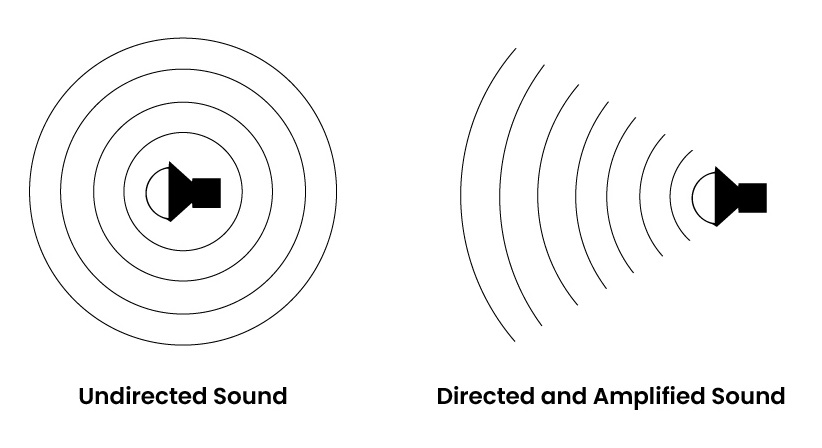
- (II) Why do we lean forward while climbing a hill?
While climbing up the hill, we have to lean forward because of the Centre of Gravity (CG) of the human body.
Explanation:
The centre of gravity is a hypothetical point in the human body through which its mass and weight are evenly dispersed to maintain balance against the Earth’s gravitational force. In normal human body posture, the centre of gravity keeps intact between two feet in a vertical direction. However, if we keep the posture unchanged while climbing up, our feet get ahead of our centre of gravity because the hill is not flat, which causes instability, and we fall off. So, when we lean forward, the CG comes between our feet, and the mass of the body is back over our feet. Hence, leaning forward while climbing a hill is a natural adjustment that many people make to maintain balance, improve stability, and efficiently distribute their body weight.
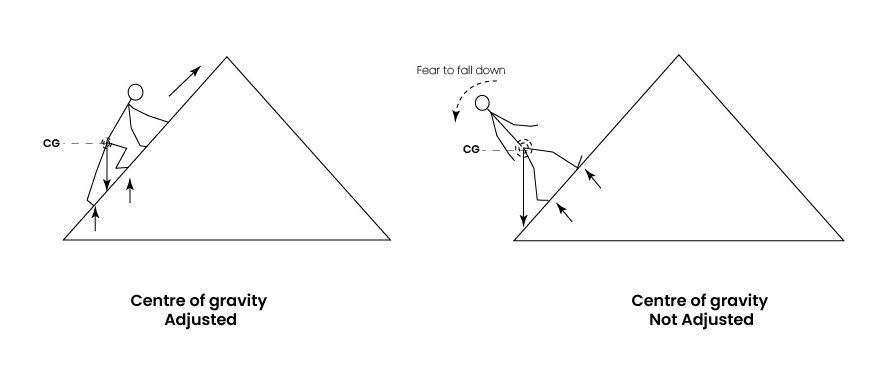
- (III) Why does a swimming pool appear less deep than it actually is?
A swimming pool appears shallow than it is primarily due to a process called “refraction of light.”
Explanation:
Refraction of light is the phenomenon in which light bends when light passes from one medium (such as air) into another medium (such as water) with a different optical density due to a change in the speed of light as it crosses the boundary between the two mediums. Therefore, light rays coming from the bottom of the pool bend away from normal while passing from the water into the air. As a result, it forms an image of the bottom of the pool at the point where the rays are produced back and make the pool appear shallower than it actually is. The whole phenomenon is governed by Snell’s law, which gives the relationship between the angle of incidence of light and the angle of refraction.

- (IV) Why cannot petrol fire be extinguished by water?
Petrol fire cannot be extinguished by water because the density of water is thicker than petrol.
Explanation:
Petrol is a hydrocarbon, and water is a polar solvent. Hence, they are immiscible liquids that do not mix or react with each other. Moreover, petrol has a density less than that of water. So, when water is poured on petro fire, water being heavier and insoluble permits the petrol to rise to the surface and continue to burn. Besides, the existing temperature is so high that the water poured on the fire evaporates even before it can extinguish the fire.
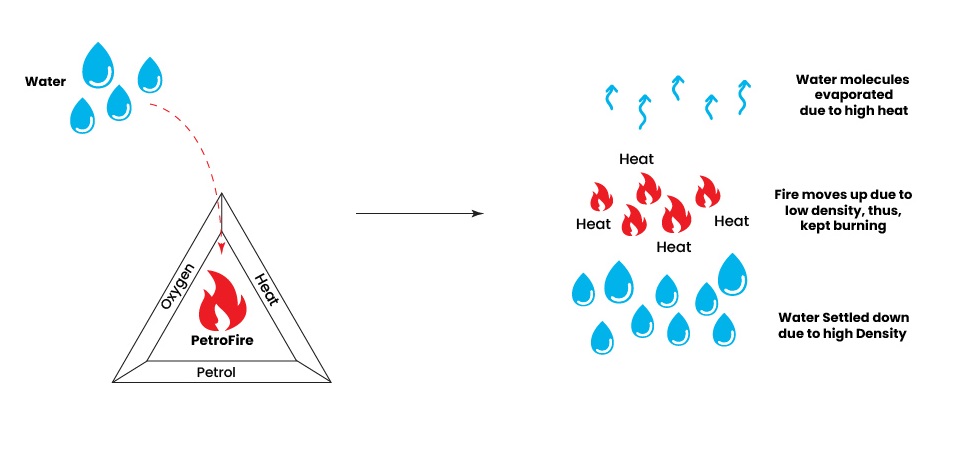
- (V) Why do Australians celebrate their Christmas during summer?
Australia celebrates Christmas in summer because of the tilt and rotation of the Earth.
Explanation:
Australia is located in the southern hemisphere. Unlike many parts of the Northern Hemisphere, where Christmas falls during the winter months, Australia experiences its summer season from December to February. This reversal in seasons is due to the tilt of the Earth’s axis, which is 23.4 degrees, and its orbit around the sun.


Question No. 4
Differentiate between:
(a) Hypoglycemia and Hyperglycemia
(b) Renewable and Non-renewable energy resources
(c) Lava and Magma
(d) Mist and Fog
(e) Lunar Eclipse and Solar Eclipse
Question Breakdown:
The question consists of five parts, each part carrying two marks. Moreover, the question particularly demands the difference between the two given terms in each part. Thus, to answer each part, draw a table of differences, either columns or three columns – one with the characteristics name, explaining 4 to 5 differences; there is no need to write much. Keep in mind the weightage while answering questions. Here, the questions are mostly attempted for five marks that can help you in your coming exams, as in an updated pattern of paper, in which every part contains five marks. Don’t forget to draw diagrams if any.
Answer
- (I) Hypoglycemia and Hyperglycemia
| Characteristics | Hypoglycemia | Hyperglycemia |
| Definition | Deficiency of glucose in the bloodstream | Excess of glucose in the bloodstream |
| Blood Sugar Level | <70 mg/dL | >130 mg/dL |
| Causes | Skipping meals, Excessive physical activity without sufficient food, Overdose of insulin or other diabetes medication, Certain medical conditions | After a high-carbohydrate meal, Uncontrolled diabetes, Stressful situations, Lack of physical activity |
| Symptoms | Seizure, headache, hunger, dizziness, sweating, Rapid heartbeat, fainting | Blurred vision, concentration difficulty, infections, weight loss, extreme thirst, frequent urination, hot, dry skin |
| Potential Complication | Diabetic Ketoacidosis | Hyperosmolar Hyperglycemic Non-ketotic Syndrome |
| Treatment | Consuming glucose-rich foods or drinks Glucagon injection in severe cases | Adjusting insulin dosage or using other medications Lifestyle changes, including diet and exercise |
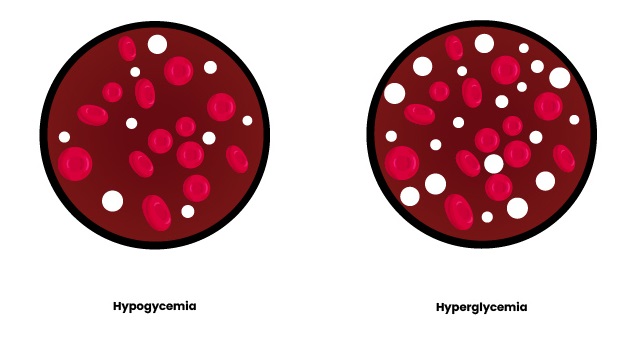
- (II) Renewable and Non- Renewable Energy Resources
| Characteristics | Renewable Energy | Non- Renewable Energy |
| Definition | The sources of energy which on usage can’t be lost forever, but can be recycled and replenished | The sources of energy that on usage are lost forever and can’t be recycled and replenished |
| Biodegradability | Renewable energy sources are eco-friendly and do not cause much pollution in the atmosphere | Non-renewable energy sources are not eco-friendly and cause a lot of pollution in the atmosphere due to the emission of excessive carbon |
| Recycling and Reusability | These energy sources can easily be reused and recycled | One cannot reuse and recycle these types of energy resources |
| Sustainability | These resources are sustainable | These energy resources are not sustainable; instead, they are exhaustible |
| Storage and Installation Cost | The overall cost of these energy sources is high. It required high capital to install and maintain these sources of energy | The overall cost of these energy sources is not very high because they can be found naturally |
| Examples | The five major sources of renewable energy are solar, wind, hydro, geothermal, and biomass | The non-renewable resources are coal, nuclear elements, oil, natural gas, and fossil fuel |

- (III) Lava and Magma
| Characteristics | Lava | Magma |
| Definition | The molten liquid that gets shot out of the Earth’s surface | Molten rock, consisting of volatile Substances, lying beneath the Earth’s surface |
| Origin of Term | Originated from the Italian Language | Originated from Ancient Greek |
| Temperature Range | Slightly colder, ranging from 1300 to 2200 degrees Fahrenheit | Slightly hotter, ranging from 1300 to 2400 degrees Fahrenheit |
| Cooling Rate | Cools more quickly upon reaching the surface | Requires more time to cool due to being underground |
| Texture | Often has a rough and porous texture due to rapid cooling | Can have a coarser texture due to slower cooling |
| Rock Formation | Forms volcanic rocks, e.g., Basalt. | Forms plutonic rocks, e.g., Granite. |
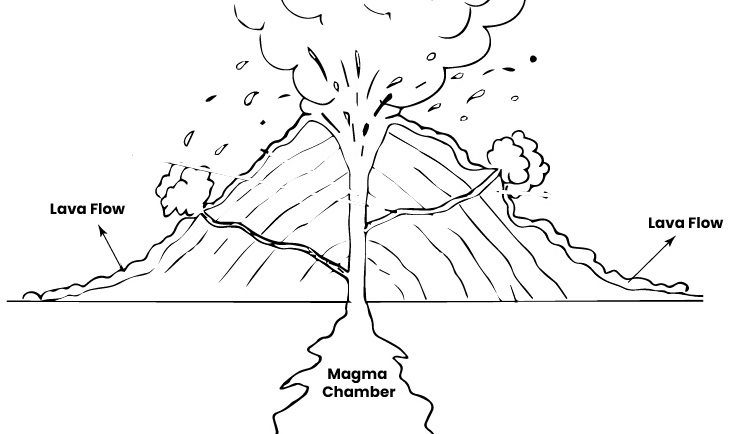
- (IV) Mist and Fog
| Characteristics | Mist | Fog |
| Definition | .Mist is the tiny water droplets hanging in the air | Fog shows up when water vapour condenses |
| Formation | Suspension of water droplets due to abrupt cooling, forming a cloud layer. | Gas liquefies into small droplets, creating a thick cloud layer. |
| Density | Low density and less thickness | High density and more thickness |
| Duration | Typically short-lived, Dissipate quickly | Generally longer-lasting due to high density |
| Visibility | Visible between 1-2 km. | Usually visible for less than 1 km. |
- (V) Lunar Eclipse and Solar Eclipse
| Characteristics | Lunar eclipse | Solar eclipse |
| Definition | Happens when the earth passes in between the moon and the sun. During a lunar eclipse, the earth’s shade partially or fully hides the moon for a brief period of time. | Happens when the moon passes in between the Earth and the sun. During a solar eclipse, the moon partially or fully hides the sun’s rays for a few minutes. |
| Eclipse and its types | Has two types, namely •Partial lunar eclipse •Total lunar eclipse •Penumbral lunar eclipse | Three types of solar eclipses, namely •Partial solar eclipse •Annular solar eclipse •Total solar eclipse |
| Frequency of occurrence | Twice a year, during the nighttime | Usually once in eighteen months during the daytime |
| Duration | The time period of the lunar eclipse is almost an hour | The longest duration is around seven and a half minutes |
| Form of Appearance | The moon appears slightly reddish in colour | A bright disk of sunlight around the new moon. |
| Phases of moon | In the full moon phase | In the new moon phase |
| Risk for health | Watching with the naked eye is absolutely safe | Cannot be seen directly through the naked eyes, because of the high chance of losing vision as it can damage the retina. |


Question No. 5
Briefly explain the working principle of the following:
(a) Radar
(b) Microwave Oven
Question Breakdown
In this particular question, there are two parts which you are supposed to answer. To deal with it, first, write a basic definition of the instrument, with its u,i.e., Radar and Microwave oven, and then explain a brief principle of working. Moreover, you can draw block diagrams, if any. Remember, writing too much can never help you get good marks in your GSA paper, but the presentation- diagrams, tables, flowcharts- does. Thus, solve our paper carefully.
Answer:
- (I) RADAR
RADAR is Radio Detection and Ranging. It is a technology used for detecting and tracking objects by transmitting radio waves and analyzing their reflections to identify obstacles to control the area of the spot or range of an object. It is used in various applications, including aviation for aircraft navigation and collision avoidance, meteorology for weather tracking, maritime navigation, military surveillance, and traffic control.
Working of RADAR:
The principle behind the working of RADAR is “The Doppler Effect”- the change in frequency or wavelength of waves (such as sound, light, or radio waves) in relation to an observer moving relative to the source of the waves. The RADAR system emits electromagnetic radio waves, which spread through space at the speed of light. When these waves encounter an object, they reflect back as echoes. A receiver receives these echoes, carrying information about distance, direction, and object traits. Precise time measurement of wave travel yields distance, and signal processing determines time delay and frequency shift, indicating object speed.
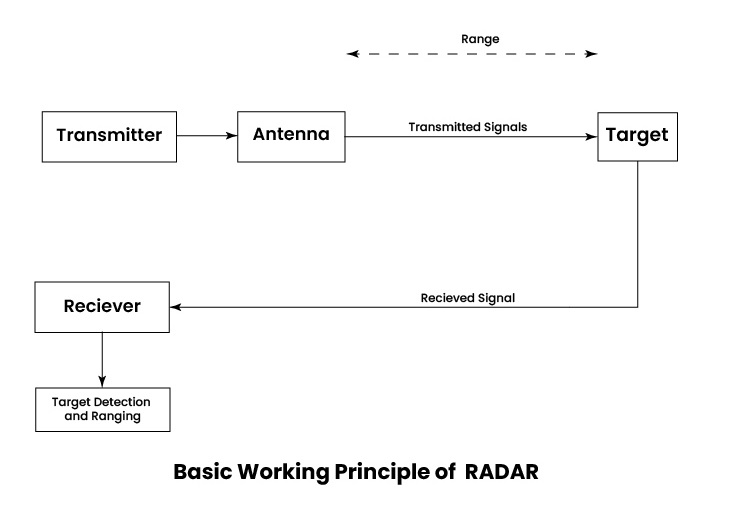
- (II) Microwave Oven
The micro oven is a simple device operating at a very high frequency and is used for heating and cooking purposes.
Working of Microwave Oven:
The working principle of a microwave oven involves the generation and utilization of microwave radiation. Microwave works on the principle of conversion of electromagnetic energy into thermal energy. The oven generates microwave radiation – a very high energy electromagnetic radiation with a frequency ranging between 300 MHz and 300 GHz and wavelength from 1 mm to around 30 cm approximately when switched on. When a polar molecule (like water) present in the food falls in the path of these EM radiations, it oscillates to align with them, changing the electric field of the microwaves. It, as a result, leads to their rapid oscillation and the conversion of electromagnetic energy into thermal energy, which heats the food. Frequency and wavelength allow microwaves to penetrate deep inside the food and cook it from inside while the temperature of the air present around the food remains constant as air is non-polar.

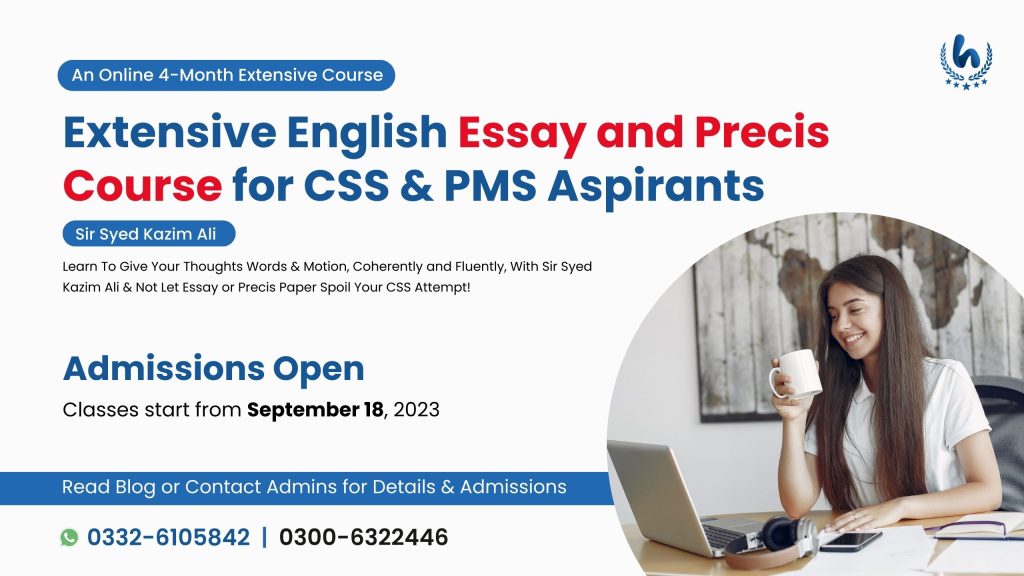
Question No. 6
Give brief explanations for following phenomena:
(a) While watching a cricket match we see the ball struck a moment before we hear the sound of the bat hitting the ball.
(b) A ship though made largely of steel, which is heavier than water, floats in water.
(c) The colour of the same cloth when seen in electric light appears different from the colour when seen in day light.
(d) Glass when heated cracks while metal does not.
(e) Although each eye perceives a separate image, we do not see everything double.
Question Breakdown:
In this question, the examiner has asked the reasoning questions in all the five parts, with each part carrying two marks. So, to answer them, all you have to do is answer it in a line first. And then prove the point by giving a reason. Remember to add formulas, examples, diagrams, etc., where required.
Answer:
- (I) While watching a cricket match we see the ball struck a moment before we hear the sound of the bat hitting the ball.
While watching a cricket match, we see the ball struck a moment before we hear the sound of the bat hitting the ball due to the difference between the speed of light and the speed of sound in air.
Explanation:
Sound is a mechanical wave which requires a material medium for its propagation. Hence, when more particles are available for propagation, more is the speed of sound. In solids, the atoms are tightly packed with each other, providing a pathway for sound waves. On the other hand, the sound waves in air move slowly due to the loosely bound particles in a gas. On the other hand, light waves travel way faster in air than sound. Thus, the visual information of the event reaches our eyes well before the sound waves reach our ears. This delay between the visual and auditory perceptions is why we see the ball being struck before we hear the sound of the bat hitting it.

In other words, light travels 186 thousand miles in 1 second, while sound takes almost 5 seconds to travel 1 mile.
- (II) A ship though made largely of steel, which is heavier than water, floats in water.
A ship, though made largely of steel, which is heavier than water, floats in water because of the density difference between the hollow ship and water.
Explanation:
A factor that decides whether the object will sink or float when immersed in a particular liquid is Relative Density, which is the ratio of the density of the substance to the density of water.

Since a ship that is apparently made of iron and steel is a hollow structure from the inside, containing a lot of air in it, it has a very low density than water. Thus, due to the presence of a lot of air in it, the average density of the ship becomes less than that of the density of water, which causes it to float rather than sink.
- (III) The colour of the same cloth when seen in electric light appears different from the colour when seen in day light.
The colour of the same cloth, when seen in electric light, appears different from the colour when seen in daylight due to the difference in the spectral composition of both lights.
Explanation:
The retina of the eye perceives colour due to reflected wavelengths of light. Although sunlight and electric light both appear as white light, each contains slightly different wavelengths. Natural sunlight shows a balanced spectrum of colours across the visible spectrum. On the other hand, the electric light varies due to its composition and inbuilt colour temperature- cooler or warmer tone, having more yellow or more blue wavelength, respectively. When the retina of the eye perceives the colour of the clothing, it really perceives those differing reflected wavelengths, thus appearing different.
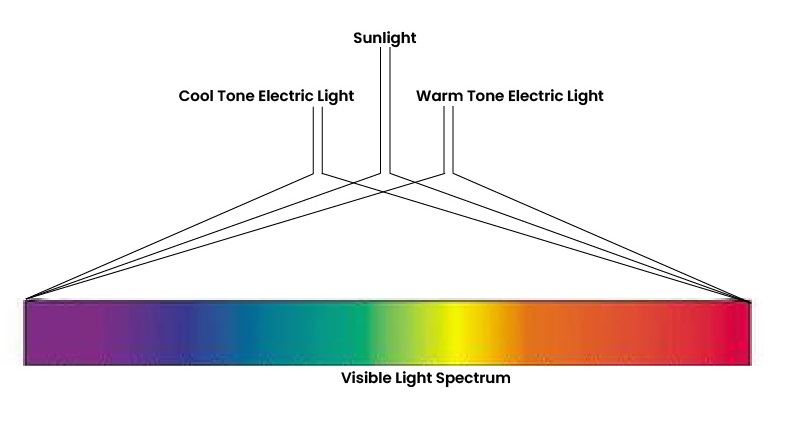
- (IV) Glass when heated cracks while metal does not.
Glass, when heated, cracks, while metal does not because of its insulating structure and thermal expansion coefficient.
Explanation:
Glass has a relatively low thermal conductivity, has a very low thermal expansion coefficient and can be brittle in nature. On heating, the heat does not transmit from the glass quickly, which results in unequal expansion of the inner and outer surface of the glass, leading to cracks or even shattering. On the other hand, metals have high thermal conductivity, i.e., high thermal expansion coefficient and ductile nature. On heating, the heat from the metal is quickly transmitted from one part to another part and allows it to accommodate the expansion more effectively by deforming slightly without fracturing.

- (V) Although each eye perceives a separate image, we do not see everything double.
Despite each eye perceiving a separate image, we do not see everything double due to our brain’s intricate processing and coordination.
Explanation:
The eyes detect and respond to light and send signals to the brain. While each eye perceives a slightly different view of the same scene due to its position on the face, there is a significant overlap in the visual fields of the two eyes. In brain, the information from the two eyes is integrated to create a unified perception of the scene. Once the processing is done, a three-dimensional aspect is obtained, which enables us to experience the length, width, and height of the object, which is called Stereopsis. The two eyes collectively help the brain to create a sense of depth and distance.

Question No. 7
Write short NOTES on the following:
(a) Environmental effects of Fertilizer use.
(b) Global Warming
Question Breakdown:
The question consists of two parts. In the first part, the examiner has asked you to write down the environmental impacts of fertilizer use. To answer this, first define fertilizers with their types/ examples, giving minimum weightage. Then, directly land to the effects of fertilizer use with a special focus on the environment. Remember, do not write general effects. Then, in the next part, the examiner wants you to write a note on global warming. To answer this, define global warming with its causes, impacts and solutions or in any way you want while being relevant. Remember, do not forget to draw keys and diagrams where necessary.
Answer:
- (I) Environmental Effects of Fertilizer Use:
Define Fertilizers:
Fertilizers are chemicals or substances that contain one or more plant nutrients and are supplied to the crops to increase their growth and yields. They supplement the natural nutrient content of the soil, ensuring that plants have an adequate supply of essential nutrients for healthy development.
Types and Examples of Fertilizers:

Environmental Impacts of Fertilizers:
Although fertilizers increase the food production rate, because of frequent use, fertilizers are leading to irreparable environmental impacts that are as follows
- Causing Water Pollution
Excessive use of fertilizer can lead to the runoff of nutrients like nitrogen and phosphorus that can end up in bodies of water such as rivers, lakes, and oceans. This nutrient runoff can cause nutrient pollution, leading to harmful blooms of algae and oxygen depletion, known as eutrophication, which can have a negative impact on aquatic ecosystems and the life that inhabit them.
- Leading to Soil Degradation
Excessive use of nitrogenous fertilizers causes considerable changes in the natural pH of the soil, reduction in soil fertility, and disruption of soil microbial communities, making soil useless with time.
- Contributing Green House Emissions
Nitrous Oxide emerges in very large amount from nitrogen-based fertilizers. The NOx are the potent greenhouse gases that can greatly contribute to global warming, ozone depletion and the associated impacts.
- Impacting Air Quality:
Fertilizers mostly have nitrogen as their main component, which can contribute to air pollution in multiple ways. For instance, ammonia emission from fertilized land may be oxidized and turned into nitric acid and sulphuric acid causing acid rain.
- Leading to the loss of biodiversity:
Excessive nutrient runoff due to the overuse of fertilizers can lead to the overgrowth of certain plant species in aquatic ecosystems, disrupting natural habitats there. Moreover, the use of certain fertilizers can negatively impact beneficial insects like bees and other pollinators, leading to more harm than good.
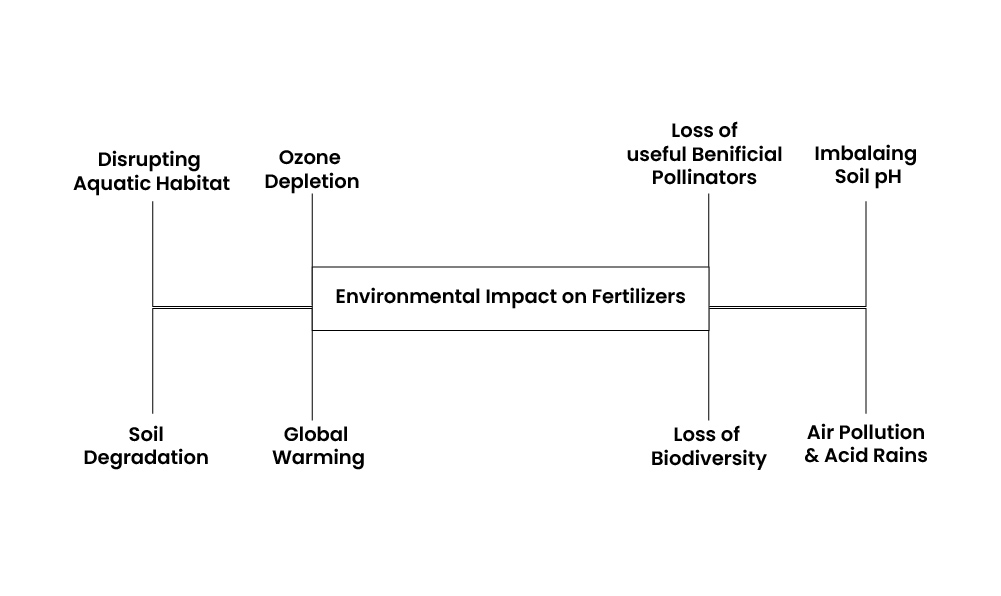
- (II) Global Warming
Define global Warming:
The rising of the average temperature on the Earth is known as global warming, mainly as a result of the greenhouse effect. The greenhouse gases act like insulation to keep the Earth warm. However, as more greenhouse gases get into the atmosphere, the Earth will start to grow warmer. The main greenhouse gases are water vapours, carbon dioxide, and methane.
Causes of Global Warming:
Global warming is an alarming situation caused by several activities on the Earth, like deforestation, waste disposal, overconsumption, mining, fossil fuel burning, and intensive farming.
- Deforestation: Cutting down forests reduces the planet’s capacity to absorb carbon dioxide (CO2) from the atmosphere, leading to higher levels of this greenhouse gas and contributing to warming.
- Waste Disposal: Improper waste disposal, such as landfill decomposition and incineration, releases methane (CH4) and CO2, both potent greenhouse gases, into the atmosphere.
- Over Consumption: Excessive consumption of goods requires more energy for production and transportation, increasing greenhouse gas emissions from manufacturing processes and fossil fuel use.
- Mining: Extracting minerals and fossil fuels releases methane and CO2 during extraction, processing, and transportation, adding to greenhouse gas levels.
- Fossil Fuel Burning: Fossil fuels, including coal, natural gas, and petroleum, are used in automobile engines, power generators, industries etc., and release a lot of CO2, CO, and other such gases that trap in the atmosphere and cause earth temperature to increase.
- Intensive Farming: Industrial agriculture releases methane from livestock digestion and manure, along with nitrous oxide (N2O) from fertilizers, intensifying greenhouse gas concentrations.
Impacts of Global Warming:
The major impacts of global warming are as follows
- Melting of Glaciers: Many glaciers are already melting and shrinking throughout the world due to increased temperatures.
- Rising Sea Levels: As the glaciers melt, the ocean levels will rise. This could cause flooding in cities located near coastal areas.
- Disrupting Food Chain: Animals will migrate to cooler spots as their old habitats get too warm. This could upset the food chain and put some species in danger of extinction.
- Increasing Natural Disasters: Global warming will cause more powerful hurricanes, famines, droughts and flooding in different areas of the world.
- Erratic Weather Pattern: Cold weather biomes such as the tundra will shrink, while desserts will continue to expand due to extreme changes in temperature.
Ways to Prevent Global Warming
Although global warming has reached the point where collaborative efforts are the need of the hour, the following measures can contribute to the prevention of global warming.
- Plant more trees to enhance carbon sequestration and improve air quality.
- Install waste processing plants to manage and reduce pollution from waste disposal.
- Switch to alternative energy sources to decrease reliance on fossil fuels.
- Introduce sustainable transportation options to reduce emissions and congestion.
- Promote the mantra of reduce, reuse, and recycle for resource conservation.
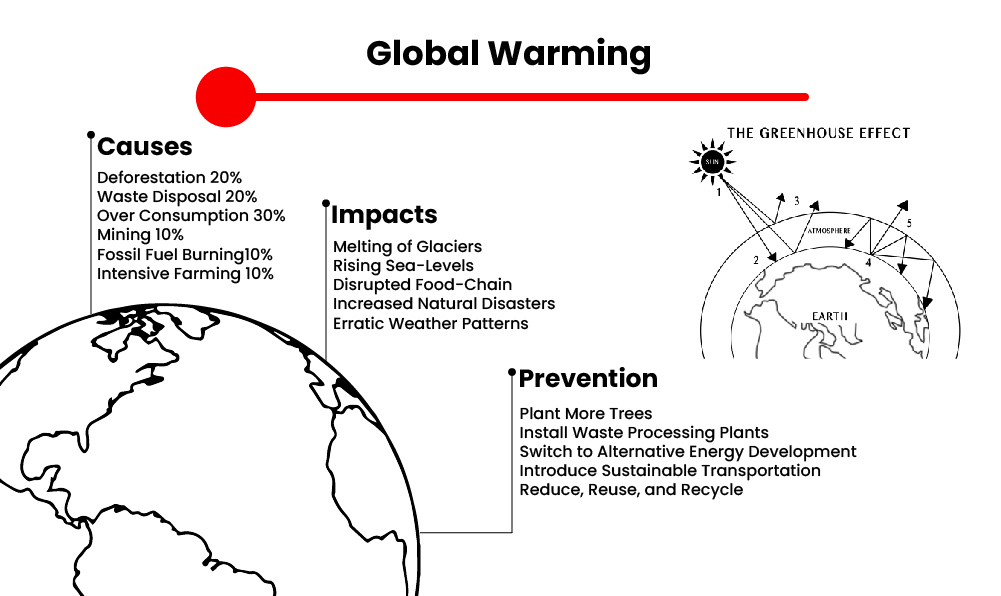

Question No. 8
Differentiate between:
(a) Smog and Smoke
(b) Radiotherapy and Chemotherapy
(c) Diastolic and Systolic blood pressure
(d) Infection and Allergy
(e) Conductors and Insulators
Question Breakdown:
The question consists of five parts, each part carrying 2 marks. Moreover, the question particularly demands difference between the two given terms in each part. Thus, to answer each part, draw a table of differences, either columns or three columns – one with the characteristics name, explaining 4 to 5 difference, there is no need to write much. Keep in mind the weightage while answering questions. Here the questions are mostly attempted for five marks that can help you in your coming exams as in updated pattern of paper, in which every part contains five marks. Don’t forget to draw diagram if any.
Answer
- (I) Smoke and Smog
| Characteristics | Smoke | Smog |
| Define and Composition | Smoke contains a lot of particulate pollutants which pollute the air. | Smoke mixed with dust particles and small drops of fog is called smog. |
| Formation Process | Results from incomplete combustion without enough oxygen, producing visible unburned particles- solid particles (e.g., soot, ash) and gases (e.g., CO, CO2) | Forms when pollutants react with sunlight, leading to ground-level ozone and fine particulate matter. |
| Particle Size | Refers to particulate matter with a size of less than 10 microns | Contains various-sized particles due to the mixture |
| Environmental Impact | Less significant environmental impacts and generally presents lower health risks. | Can contribute to air quality and environmental issues and can have severe consequences on the eyes and respiratory system. |
| Density | The low density of visible particles thus does not impact much on visibility | High density due to the concentration of pollutants, thus, reduces visibility |

- (II) Radiotherapy and Chemotherapy
| Characteristics | Radiotherapy | Chemotherapy |
| Definition | Use of high-energy X-rays or particles to destroy cancer cells | Use of powerful chemical drugs to kill fast-growing cancer cells |
| Treatment Method | Uses ionizing energy, such as X-rays or protons, targeted at the tumour. | Involves systemic administration of cytotoxic drugs. |
| Cell Targeting | Targets a specific tumor or region | Affects cells throughout the body |
| Delivery Methods | External radiation via machine. | IV process using a needle or tube. |
| Side-effects | Fatigue, skin conditions, stiffness, swelling, digestive issues, etc. | Fatigue, hair loss, anaemia, weakness, nausea, vomiting, etc. |
| Implications | Can have effects beyond the primary tumour area but not always | Impacts cells throughout the body |
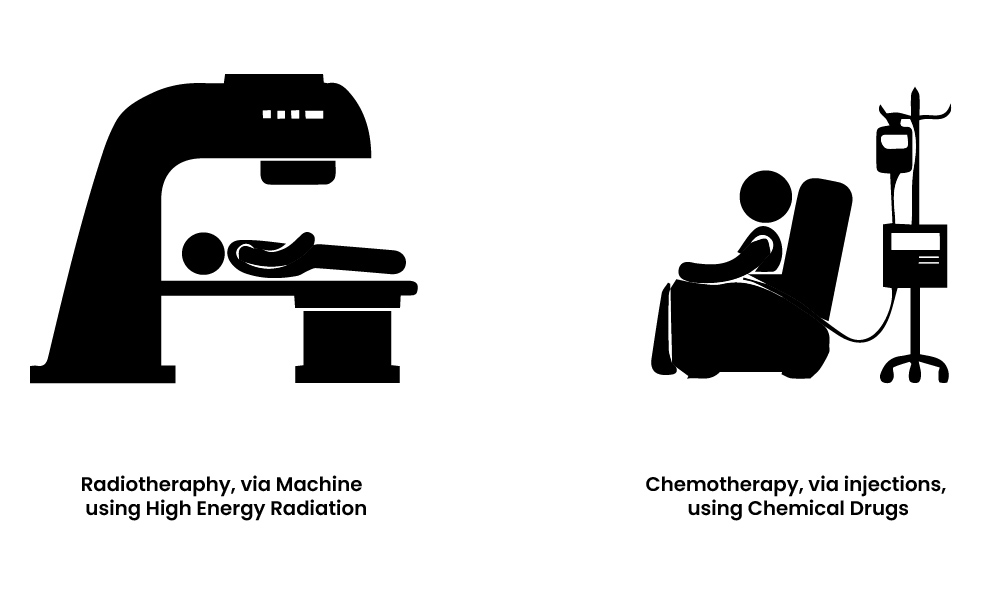
- (III) Diastolic and Systolic Blood Pressure
| Characteristics | Systolic Pressure | Diastolic Pressure |
| Definition | It refers to the maximum arterial pressure during the contraction of the left ventricle of the heart. | It refers to the minimum arterial pressure during the relaxation of the left ventricle of the heart |
| Normal Range (mm Hg) | 90-120 (in adults) | 60-80 (in adults) |
| Blood Pressure | Represents maximum pressure inside arteries | Represents minimum pressure inside arteries |
| Occurrence | During left ventricle contraction (systolic stage) | During left ventricle relaxation (diastolic stage |
| Cardiac Cycle Stage | Occurs in the systolic stage of the cardiac cycle | Occurs in the diastolic stage of the cardiac cycle |
| Fluctuations | Undergoes considerable fluctuations | Undergoes fewer fluctuations |
| Relationship to Age | Increases with age | Decreases with age |
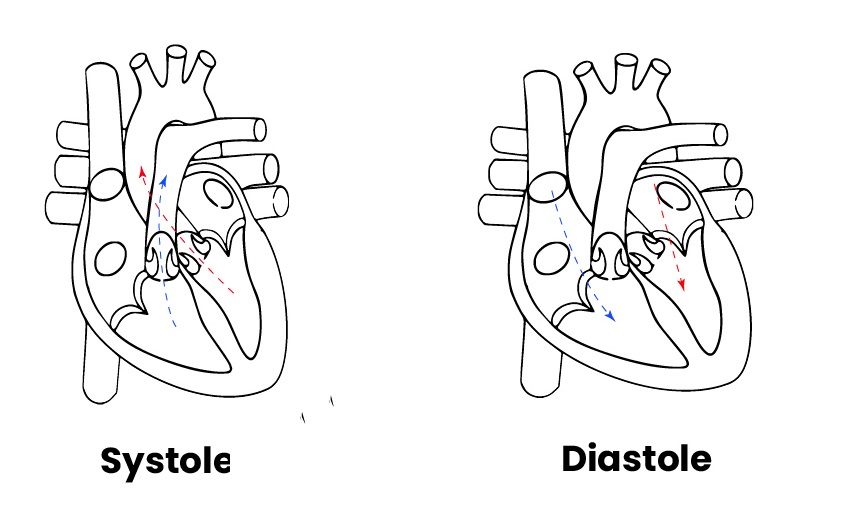
- (IV) Infection and Allergy
| Characteristics | Allergy | Infection |
| Definition | An allergy occurs due to the immune system’s reaction to certain elements such as dust, pet dander, bee venom and pollen. | Infection occurs when another organism, such as viruses, fungi, bacteria and parasites, enters the body and causes disease. |
| Causes | Exposure to Airborne allergens, Taking allergy-triggering food such as shellfish, tree nuts, soy, etc., Contact with stinging insects like bees or wasp, and Taking certain penicillin-based antibiotics. | Direct or indirect contact with an infectious person, Taking contaminated food or water Through an infected animal, From the bite of contagious insects |
| Symptoms | Hay fever, watery eyes, runny nose, itchy skin, swelling, etc. | Fever, pain in the body, fatigue and tiredness, issues related to digestion, coughing |
| Complication | Allergy-induced Asthma and anaphylaxis in severe condition | Serious diseases such as Malaria, human immunodeficiency virus (HIV), viral hepatitis, etc. |
| Prevention | Stay away from allergy-triggering elements; keep track of the cause and reaction of allergic symptoms | Maintain good hygiene practices, avoid sharing personal items, use insect repellents |
- (V) Conductors and Insulators
| Characteristics | Conductors | Insulators |
| Definition | The materials that allow the electric charge or current to pass through | The materials that do not allow the passage of electric charge or current |
| Energy Storage | Stores energy and exhibits high conductivity | Doesn’t store energy and has low conductivity |
| Electrical Resistance | Low electrical resistance with weak covalent bonds | High electrical resistance with strong covalent bonds |
| Presence of Free Electrons | Contains free electrons that can move freely | Lacks free electrons for easy movement |
| Examples | Metals like silver, copper, aluminium, etc. | Non-metals like rubber, wood, plastic, etc. |
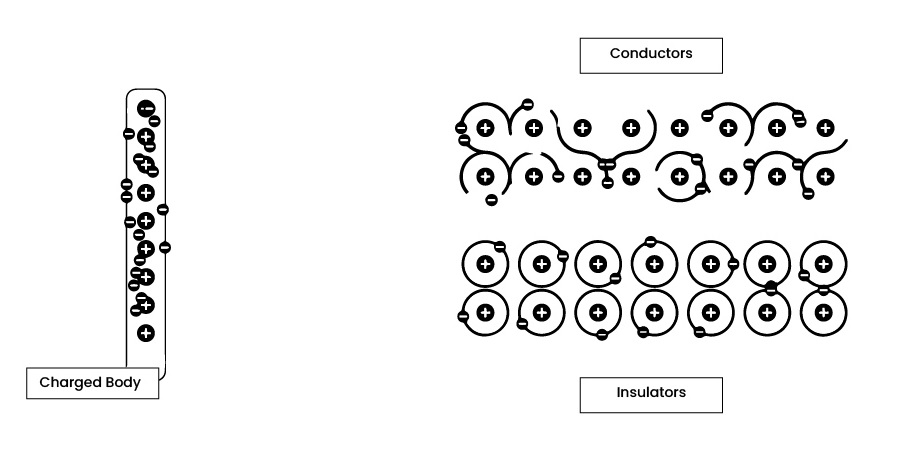
Question No. 9
Briefly explain the function of following in human body:
(a) Kidneys
(b) Lymphatic system
(c) Thyroid gland
(d) Pituitary gland
Question Breakdown:
The question consists of four parts, and each part demands the function of the given structures. Keep in mind before answering the question that each part contains 2.5 marks. Thus, answer accordingly. First, define every given term, and then directly move to the functions. Explaining the four functions of each is suggested by not indwelling much into the explanation. Most importantly, since the question involves structures, do not forget to draw diagrams with proper labelling. Remember, writing too much can never help you obtain maximum marks. Thus, answer carefully. Further, the same questions will be asked in one way or another in the next years; thus, do not forget to prepare these as five marks questions, too.
Answer:
- (I) Kidney:
Definition of Kidneys:
The kidneys are a pair of bean-shaped organs situated in the upper abdominal cavity, one on each side of the spine, below the ribs and behind the belly. Each kidney is approximately 3 cm thick, 6 cm wide, and 12 cm long, roughly the size of a large fist, with a reddish-brown colour. Functional units of the kidney are called nephrons, which are millions in number per kidney and responsible for carrying out the primary functions of the kidneys.
Functions of Kidneys:
The kidneys are vital organs in the human body, playing a crucial role in maintaining overall health and homeostasis. They manage fluid levels, electrolyte balance, and other factors that keep the internal environment of the body consistent and comfortable. Some other functions are given below:
- Blood Filtration:
Kidneys filter blood in the glomerulus to remove waste, creating glomerular filtrate through a porous surface due to filtration pressure.
- Water & Nutrient Re-absorption:
Proximal tubules reabsorb useful substances; the loop of Henle reabsorb water and ions via a countercurrent multiplier.
- Excretion of Wastes:
Kidneys excrete waste like urea, creatinine, uric acid, and metabolic byproducts of protein breakdown.
- pH & Electrolyte Balance:
Kidneys regulate pH by excreting hydrogen ions, reabsorbing bicarbonates, and balancing electrolytes via hormone control.
- Active Secretion:
Tubular cells of the kidney secrete erythropoietin (controlling red blood cell production), renin (maintaining fluid balance), and calcitriol (regulating calcium).

[The same question has been asked in GSA paper 2023, Question no. 3 (b) and GSA paper 2015, Question no. 3(b) with a special reference to the role of the kidney in excretion. There, you are supposed to answer it differently.]
- (II) Lymphatic System:
Definition of Lymphatic System:
The lymphatic system is the network of vessels through which lymph drains from the tissues into the blood. The lymphatic system consists of all lymphatic vessels and lymphoid organs. For example, the lymph nodes, spleen, thymus as well as the lymphatic tissue found in the small intestine (Peyer’s patches) and throat (adenoid tonsils, palatine and tubal tonsils), to name a few, all represent lymphatic organs.
Functions of the Lymphatic System:
The lymphatic system serves as a vital component of the body’s immune response, fluid balance, and nutrient absorption. The major functions include
- Fluid Balance and Sewerage System:
The lymphatic system works as the body’s sewerage system, removing excess fluids that leak out of blood vessels. Moreover, it helps maintain fluid levels in body tissues, preventing tissue swelling and oedema.
- Immune Response Support:
The lymphatic system is essential for the optimal functioning of our general and specific immune responses. Lymph nodes monitor and filter lymph, producing cells and antibodies that protect the body from infections and diseases.
- Lymphocytes Production:
Lymphatic organs like the spleen and thymus are involved in the production of lymphocytes that contribute to the body’s defense mechanisms playing a role in detecting and responding to pathogens and malignant cells.
- Fat Absorption and Nutrient Transport:
Lymph vessels called Lacteals transport dietary fats and fat-soluble vitamins to the bloodstream.
- Potential Impact on Health:
If the lymphatic system is impaired due to underdevelopment, surgery, radiotherapy, or tissue damage, it can lead to lymphedema—a swelling, often in the limbs, caused by fluid buildup. Moreover, poor lymphatic function might be linked to conditions like obesity, Crohn’s disease, and other disorders.
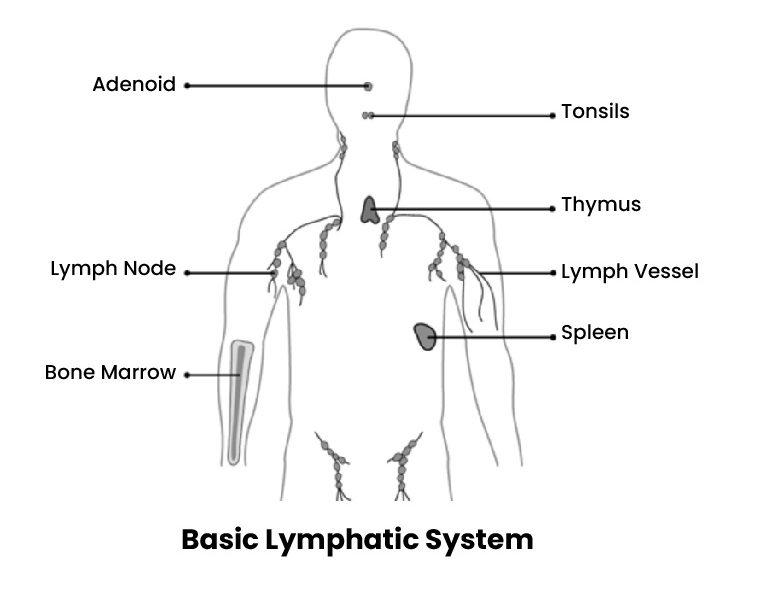
- (II) Thyroid Gland:
Definition of Thyroid Gland:
The thyroid gland is one of the largest butterfly-shaped endocrine glands in the human body. It consists of two lobes situated lateral to the upper portion of the trachea, just inferior to the larynx. The main hormones secreted by the thyroid glands are Thyroxine (T4), triodothyronine (T3), and Calcitonine.
Function of Thyroid Gland:
- Basal Metabolism:
T3 and T4 produced by the thyroid gland act on basal metabolic rate by stimulating the breakdown of glucose. They influence how quickly cells convert nutrients into energy and regulate overall energy expenditure.
- Maintain Body temperature:
Thyroid hormones help control body temperature by affecting the efficiency of metabolic reactions that produce heat. They ensure the body maintains a stable internal temperature.
- Growth and Development:
Thyroid hormones act with somatotrophin ( a growth hormone produced by the Pituitary gland) to bring about growth. Moreover, they act directly on brain cells, causing them to differentiate.
- Regulates Blood Calcium Level:
Calcitonin is released in the presence of high calcium ion concentrations in blood, thus lowering the calcium level to normal. - Impact on health:
Excess thyroid Hormone can lead to Grave’s disease, with exophthalmic goitre, which can cause cardiac failure and even death. On the other hand, if congenitally deficient, it can lead to Cretinism- i.e., abnormal development.
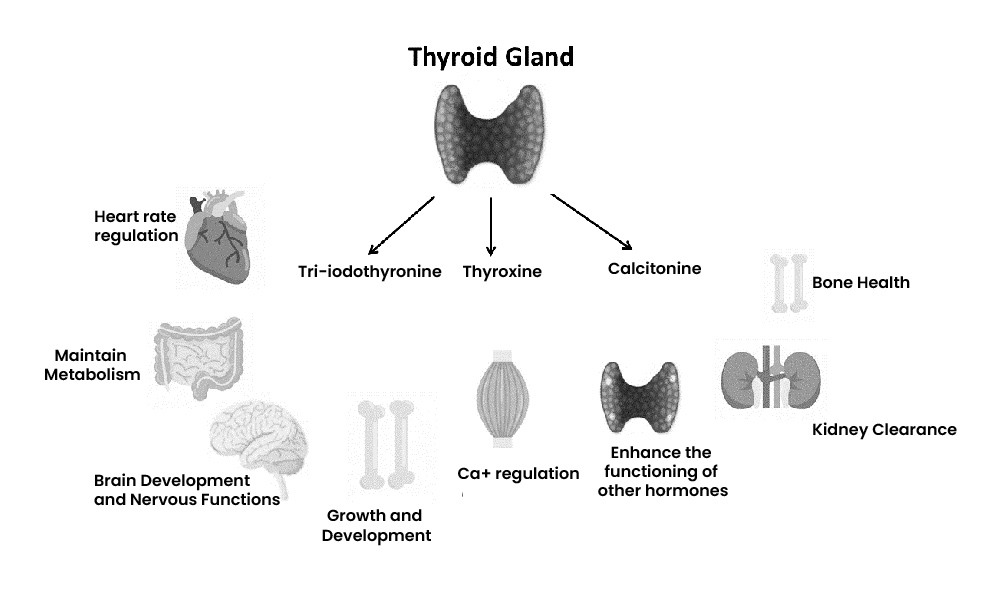
CSS Solved Past Papers’ Essays
Looking for the last ten years of CSS and PMS Solved Essays and want to know how Sir Kazim’s students write and score the highest marks in the essays’ papers? Then, click on the CSS Solved Essays to start reading them.
CSS Solved Essays
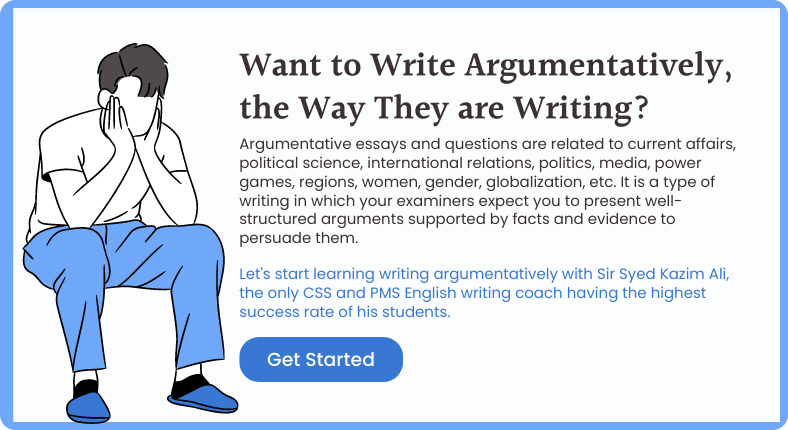
CSS Solved General Science & Ability Past Papers
| 1- | CSS Solved General Science And Ability Past Paper 2023 |
| 2- | CSS Solved General Science And Ability Past Paper 2022 |
| 3- | CSS Solved General Science And Ability Past Paper 2021 |
| 4- | CSS Solved General Science And Ability Past Paper 2020 |
| 5- | CSS Solved General Science And Ability Past Paper 2019 |
| 6- | CSS Solved General Science And Ability Past Paper 2018 |
| 7- | CSS Solved General Science And Ability Past Paper 2017 |
| 8- | CSS Solved General Science And Ability Past Paper 2016 |
| 9- | CSS Solved General Science And Ability Past Paper 2015 |
| 10- | CSS Solved General Science And Ability Past Paper 2014 |
| 11- | CSS Solved General Science And Ability Past Paper 2013 |
| 12- | CSS Solved General Science And Ability Past Paper 2012 |
| 13- | CSS Solved General Science And Ability Past Paper 2011 |
| 14- | CSS Solved General Science And Ability Past Paper 2010 |
| 15- | CSS Solved General Science And Ability Past Paper 2009 |
| 16 | CSS Solved General Science And Ability Past Paper 2008 |
| 17- | CSS Solved General Science And Ability Past Paper 2007 |
| 18- | CSS Solved General Science And Ability Past Paper 2006 |
| 19- | CSS Solved General Science And Ability Past Paper 2005 |
| 20- | CSS Solved General Science And Ability Past Paper 2004 |
| 21- | CSS Solved General Science And Ability Past Paper 2003 |
| 22- | CSS Solved General Science And Ability Past Paper 2002 |
| 23- | CSS Solved General Science And Ability Past Paper 2001 |
| 24- | CSS Solved General Science And Ability Past Paper 2000 |
Articles Might Interest You!
The following are some of the most important articles for CSS and PMS aspirants. Click on any to start reading.












